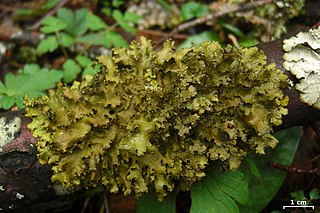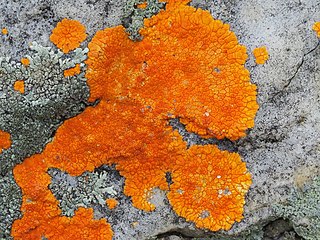
The Parmeliaceae is a large and diverse family of Lecanoromycetes. With over 2700 species in 71 genera, it is the largest family of lichen-forming fungi. The most speciose genera in the family are the well-known groups: Xanthoparmelia, Usnea, Parmotrema, and Hypotrachyna.

Ahtiana is a genus of lichenized fungi known as candlewax lichens in the family Parmeliaceae. A monotypic genus, it contains the single species Ahtiana sphaerosporella or the mountain candlewax lichen, found in western North America. This species was segregated from the genus Parmelia by Canadian lichenologist Trevor Goward in a 1985 publication. It had been suggested that the genus include A. aurescens and A. pallidula based on similarities in morphology, but this transfer is not supported by molecular analysis.

Allocetraria is a genus of lichenized fungi in the family Parmeliaceae. It consists of 12 species, with a center of distribution in China.

Arctocetraria is a genus of foliose lichens in the family Parmeliaceae. It has three species.

Cetrariella is a genus of foliose lichens in the family Parmeliaceae. It contains three species.

Kaernefeltia is a genus of lichenized fungi in the family Parmeliaceae.

Masonhalea is a genus of two species of lichenized fungi in the family Parmeliaceae.

Vulpicida is a genus of lichenized fungi in the family Parmeliaceae. Circumscribed in 1993 to contain species formerly placed in Cetraria, the genus is widespread in Arctic to northern temperate regions, and contains six species. The genus is characterized by the presence of the secondary metabolites pulvinic acid and vulpinic acid, compounds that when combined with usnic acid, give the species their characteristic yellow and green colors.

Tuckermannopsis is a genus of foliose lichens in the family Parmeliaceae.
Everniopsis is a fungal genus in the family Parmeliaceae. It consists of a single species, the bark-dwelling lichen Everniopsis trulla, which occurs in Africa and South America.

Esslingeriana is a fungal genus in the family Parmeliaceae. The genus is monotypic, containing the single foliose lichen species Esslingeriana idahoensis, commonly known as the tinted rag lichen. It is found in northwestern North America.
Himantormia is a genus of lichenized fungi in the family Parmeliaceae. The genus, which contains two species, is found in Antarctica. The genus was circumscribed by British lichenologist Elke Mackenzie in 1964.

Cetraria aculeata or the spiny Iceland lichen is a dark brown to black fruticose, soil Iceland lichen from the family Parmeliaceae. The species was first described by German naturalist Johann Christian Daniel Edler von Schreber in 1771 under the name of Lichen aculeatus. Later on Erik Acharius, the "father of lichenology" gave it a name of Cornicularia aculeata, which lately has been changed to Coelocaulon aculeatum. Finally the taxonomic revision of Ingvar Kärnefelt and colleagues assigned the species to the genus Cetraria.
Jan Eric Ingvar Kärnefelt is a Swedish lichenologist.

Usnocetraria is a genus of foliose lichens in the family Parmeliaceae.

Brownliella is a genus of crustose lichens in the subfamily Brownlielloideae of the family Teloschistaceae. It has four species. The genus was circumscribed in 2013 by Sergey Kondratyuk, Ingvar Kärnefelt, John Elix, Arne Thell, and Jae-Seoun Hur, with the widely distributed lichen Brownliella aequata assigned as the type species. The genus contains species formerly referred to as the Caloplaca cinnabarina species group. The generic name honours Australian botanist Sue Brownlie.
Kaernefia is a genus of crustose lichens in the family Teloschistaceae. It has three species, found in Australia or South Africa.
Filsoniana is a genus of squamulose lichens in the family Teloschistaceae. It has six species. It was circumscribed in 2013 by Ingvar Kärnefelt, Arne Thell, Jae-Seoun Hur, Sergey Kondratyuk, and John Elix following a molecular phylogenetic analysis of the Teloschistaceae. The generic name honours Australian lichenologist Rex Filson, "in recognition of his contribution to lichenology, in particular to the lichen flora of Australia".
Huneckia is a genus of crustose lichens in the subfamily Caloplacoideae of the family Teloschistaceae. It has four species.
Tassiloa is a genus of lichen-forming fungi in the family Teloschistaceae. It has two species.












